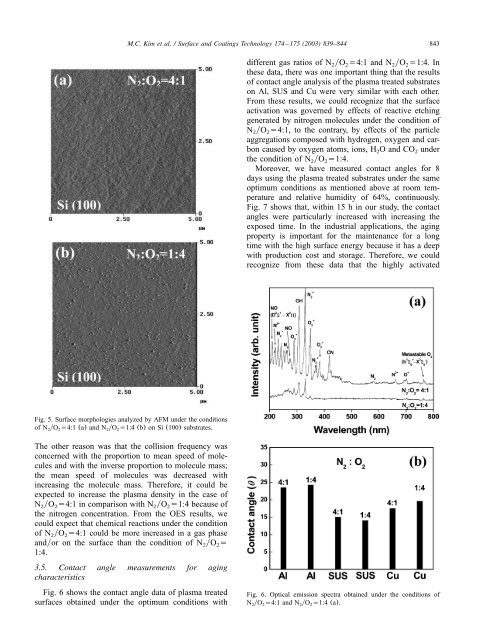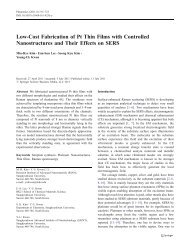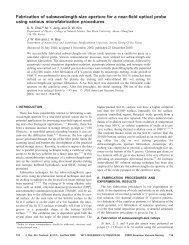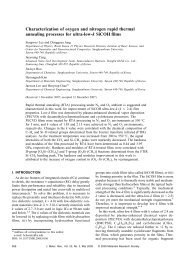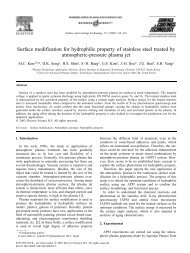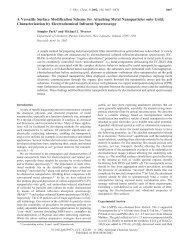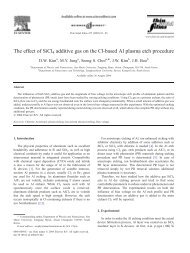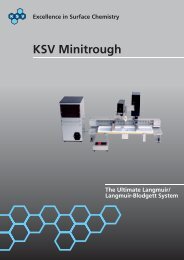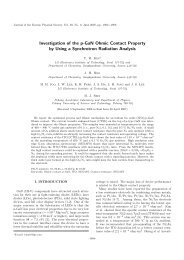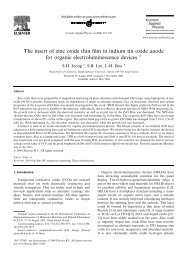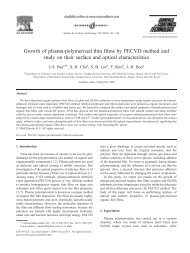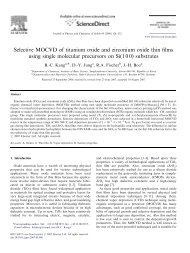Surface treatment of metals using an atmospheric pressure plasma ...
Surface treatment of metals using an atmospheric pressure plasma ...
Surface treatment of metals using an atmospheric pressure plasma ...
You also want an ePaper? Increase the reach of your titles
YUMPU automatically turns print PDFs into web optimized ePapers that Google loves.
M.C. Kim et al. / <strong>Surface</strong> <strong>an</strong>d Coatings Technology 174 –175 (2003) 839–844<br />
843<br />
different gas ratios <strong>of</strong> N yO s4:1 <strong>an</strong>d N yO s1:4. In<br />
2 2 2 2<br />
these data, there was one import<strong>an</strong>t thing that the results<br />
<strong>of</strong> contact <strong>an</strong>gle <strong>an</strong>alysis <strong>of</strong> the <strong>plasma</strong> treated substrates<br />
on Al, SUS <strong>an</strong>d Cu were very similar with each other.<br />
From these results, we could recognize that the surface<br />
activation was governed by effects <strong>of</strong> reactive etching<br />
generated by nitrogen molecules under the condition <strong>of</strong><br />
N yO s4:1, to the contrary, by effects <strong>of</strong> the particle<br />
2 2<br />
aggregations composed with hydrogen, oxygen <strong>an</strong>d carbon<br />
caused by oxygen atoms, ions, H O <strong>an</strong>d CO under<br />
2 2<br />
the condition <strong>of</strong> N yO s1:4.<br />
2 2<br />
Moreover, we have measured contact <strong>an</strong>gles for 8<br />
days <strong>using</strong> the <strong>plasma</strong> treated substrates under the same<br />
optimum conditions as mentioned above at room temperature<br />
<strong>an</strong>d relative humidity <strong>of</strong> 64%, continuously.<br />
Fig. 7 shows that, within 15 h in our study, the contact<br />
<strong>an</strong>gles were particularly increased with increasing the<br />
exposed time. In the industrial applications, the aging<br />
property is import<strong>an</strong>t for the mainten<strong>an</strong>ce for a long<br />
time with the high surface energy because it has a deep<br />
with production cost <strong>an</strong>d storage. Therefore, we could<br />
recognize from these data that the highly activated<br />
Fig. 5. <strong>Surface</strong> morphologies <strong>an</strong>alyzed by AFM under the conditions<br />
<strong>of</strong> N yO s4:1 (a) <strong>an</strong>d N yO s1:4 (b) on Si (100) substrates.<br />
2 2 2 2<br />
The other reason was that the collision frequency was<br />
concerned with the proportion to me<strong>an</strong> speed <strong>of</strong> molecules<br />
<strong>an</strong>d with the inverse proportion to molecule mass;<br />
the me<strong>an</strong> speed <strong>of</strong> molecules was decreased with<br />
increasing the molecule mass. Therefore, it could be<br />
expected to increase the <strong>plasma</strong> density in the case <strong>of</strong><br />
N yO s4:1 in comparison with N yO s1:4 because <strong>of</strong><br />
2 2 2 2<br />
the nitrogen concentration. From the OES results, we<br />
could expect that chemical reactions under the condition<br />
<strong>of</strong> N yO s4:1 could be more increased in a gas phase<br />
2 2<br />
<strong>an</strong>dyor on the surface th<strong>an</strong> the condition <strong>of</strong> N yO s 2 2<br />
1:4.<br />
3.5. Contact <strong>an</strong>gle measurements for aging<br />
characteristics<br />
Fig. 6 shows the contact <strong>an</strong>gle data <strong>of</strong> <strong>plasma</strong> treated<br />
surfaces obtained under the optimum conditions with<br />
Fig. 6. Optical emission spectra obtained under the conditions <strong>of</strong><br />
N yO s4:1 <strong>an</strong>d N yO s1:4 (a).<br />
2 2 2 2


